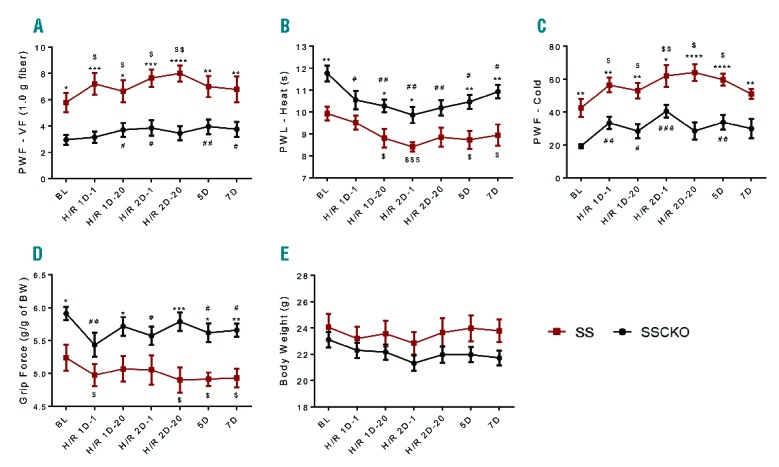Figure 3.

Effect of calpain-1 deletion on hypoxia/reoxygenation-evoked hyperalgesia in sickle mice. (A) Mechanical hyperalgesia, (B) sensitivity to heat, (C), sensitivity to cold, (D) deep tissue hyperalgesia, and (E) body weight were assessed at baseline (BL) before H/R treatment. Mice were then exposed to 8% O2/92% N2 hypoxia (H) for 3 h followed by reoxygenation (R) at room air. Pain behaviors were analyzed after 1 h (1D-1) and 20 h (1D-20). Twenty-four h later, the hypoxia treatment was repeated and pain behaviors were analyzed at 1 h (H/R 2D-1) and 20 h (2D-20). No further hypoxia treatment was performed, but pain behaviors were analyzed up to the 5th and 7th days from baseline measures. Mean age of each group of mice in months ± SEM are SS: 6.56 ± 0.38 (n=7); SSCKO: 7.86 ± 0.11 (n=10). Values on the graphs are mean ± SEM. *P<0.05; **P<0.01; ***P<0.001; ****P<0.0001 for SSCKO vs. SS (two-way ANOVA, Bonferroni). #P<0.05; ##P<0.01 vs. BL in SSCKO group (one-way ANOVA, paired t-test); $P<0.05; $$P<0.01, $$$P<0.001 vs. BL in SS group (one-way ANOVA, paired t-test). PWF-VF: paw withdrawal frequency-Von Frey; PWL: paw withdrawal latency; BW: body weight; BL: baseline; AA: Townes control mice; SS: Townes sickle mice; SSCKO: calpain-1 knockout Townes sickle mice.
